Trees
I can’t remember when my fascination with trees began. I suspect it coincides to some degree with my immersion (via Preston Art Society) in that great body of artists which I’ve labelled elsewhere as the Garde-Domestique; the worldwide web of artists (mainly painters) which range from rank beginners to highly skilled and successful professionals. What they have in common is that they are not Avant-Garde (hence my alternative French designation). The other quality that tends to characterise them, though by no means exclusively, is a predeliction for landscape. And being a chap who’s easily led (my mother always said so) it became inevitable that I’d have a look see.
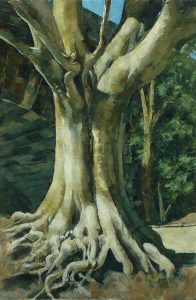
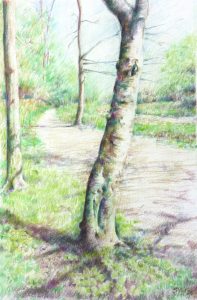 It’s at this point that the sculptor in me intervenes, because when I go out into the countryside, although I do appreciate the grand vistas and the idyllic woodland paths what I inevitably find myself attracted to are the trees. The consequence is that when I do decide to render a chunk of countryside into pencil or paint the result usually has one of these natural sculptures full front and central.
It’s at this point that the sculptor in me intervenes, because when I go out into the countryside, although I do appreciate the grand vistas and the idyllic woodland paths what I inevitably find myself attracted to are the trees. The consequence is that when I do decide to render a chunk of countryside into pencil or paint the result usually has one of these natural sculptures full front and central.
To the trained DG eye (well some of them) this is bad composition. For them the trees are beautiful, yes, but should mainly be used to frame the scene and help the spectator’s eye make it’s way through and into the picture, probably to a nice little farmhouse in the distance.
I had a different problem. I didn’t want the scene to be in the picture at all; I just wanted the tree.
This, though, caused another problem because trees don’t just stand on the ground, like the people in my full length portraits, they stand in it. In fact they thrust up through it and even, in some cases, embrace it, which makes the ground and it’s extension outwards difficult to ignore.
What follows is a tour through my attempts to solve and explore this problem.
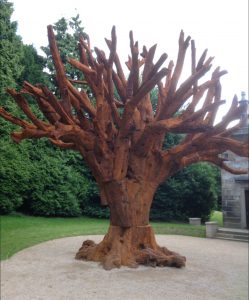
Ai Wei Wei ‘Iron Tree’
One route I didn’t take was to try and sculpt a tree. This is an obvious solution and Ai Wei Wei did it brilliantly with his Iron Tree. But I have neither the resources which Ai has accumulated, nor the outlets, so different solutions were needed.
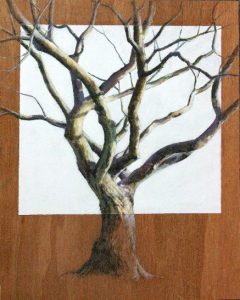
‘You Can’t See the Wood for the Tree’
“If you can’t do anything else, draw,” one of my art college lecturers once said (those five years weren’t a complete waste of time). As can be seen above I’d already done some of that (and painting) and, with no other solutions presenting themselves, I carried on. I committed one fairly sculptural tree to paper in acrylic paint, but I immediately encountered the old familiar problem – that it insisted on connecting to the ground. So I chopped the interesting bit out. This was all right but there was still something missing and I ’solved’ that by pasting the cropped image onto a wooden board and finishing the result off in coloured pencil. I called it “You Can’t See the Wood for the Tree” and put in the Art Society Summer Exhibition. I think the joke saved it – or maybe not.
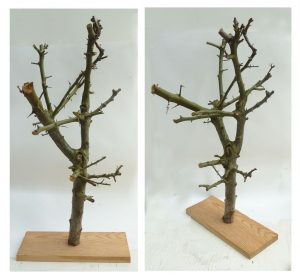
Pyracantha branch
This dalliance with the ’tree problem’ was a spasmodic affair, sandwiched in between painting portraits, writing bits and pieces here and there and generally making stuff. And then one day we were cutting back a pyracantha at the side of the house and out of the pile of lopped off foliage came a section that grabbed my attention. And I realised something – it’s a fairly obvious something but it takes me a while sometimes – I realised that small bits of tree are exactly the same as the larger bits: thick cylindrical forms haphazardly branching off into thinner ones with attractive things going on at the junctions. Here was a solution; I had, in my hand a model of a tree, perfect in every detail. So I mounted this mini tree on a base and stuck it on the shelving which houses, amongst other things, the curiosities that I’ve either encountered or made over the last few years.
Since then I’ve played with it occasionally, adding bric-à-brac to it’s base and enjoying the interplay of scale. Some of these objects, such as random stones, took on the scale of the tree, others, like a softball left over from by daughter’s schooldays contrasted with it. Inevitably I recalled my dalliance with Action Man. But Action Man dolls are hard to come by these days, or at least expensive, and since my motives were fairly low key and whimsical it remained just a thought. Until ,that is, I came across a market stall selling second hand toys and models (though I think the stall holder would have preferred the term ’collectables’ to ’second hand’). No Action Man dolls were in evidence but similar sized figures were and I bought one. It was only after I got him home that I realised it was a representation of David Tennant as Doctor Who.
No matter, he went very well with the tree. And there he still lives.
The tree now holds up an additional shelf whilst it and the good Doctor are increasingly surrounded by the paraphernalia of making art, examples of it, and other detritus.
But that was only the beginning. I started collecting twigs and drawing them. 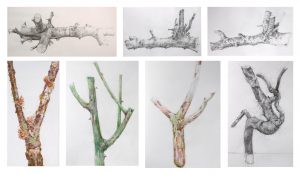
I then mounted a couple and gave the three dimensional frames or boxes.
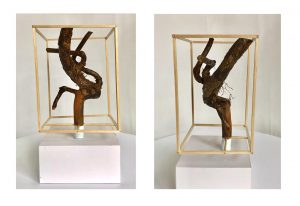
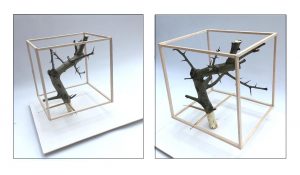
Later I incorporated one into a block of wood.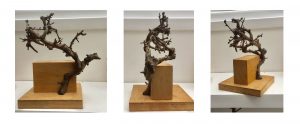
And then my Bonzai tree died. It was a moment of sadness but curiosity came to the rescue. I freed the its skeleton from the soil enclosing its roots and left it dangling between two shelves. I later mounted in its own box.
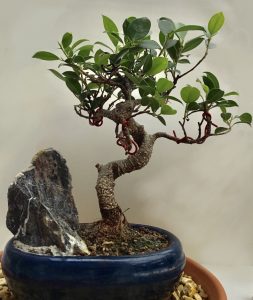
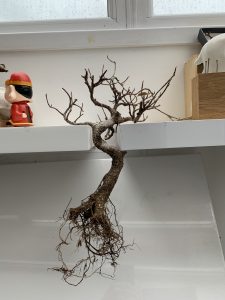
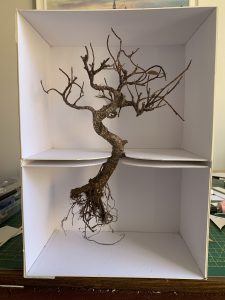
I doubt they are the end. Trees are a definite feature of my daily lockdown walk and one in particular gives me much joy. It’s a beast of tree, a giant beech which dominates all around it. Here’s an A2 size, charcoal drawing of it.
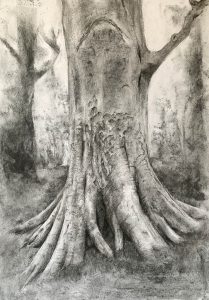
I’m contemplating doing a relief sculpture of it. Watch this space.
